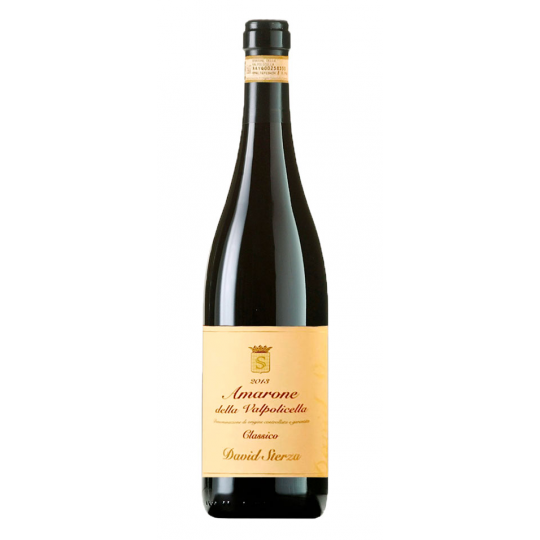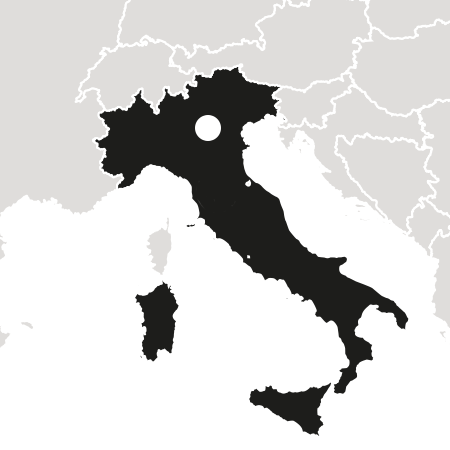Waarom deze wijn?
De geweldige Amarone van Sterza is op herhaling, maar wel met de nieuwe jaargang 2013! Ten eerste omdat het jaar 2013 vele malen mooier is dan voorgaande jaren (94 van de 100 Parker punten), ten tweede omdat wij denken dat we een groot aantal liefhebbers van Sterza er een plezier mee doen en ten derde omdat we nog net de hand hebben weten te leggen op deze fantatische verschijning! Wij hebben geproefd, WOW wat een wijn!
Balans is het kernwoord, balans en precisie. Niet voor niets, jaar op jaar, de maximale score van 3 glaasjes (=sterren) in de Gambero Rosso. In 2017 waren er slechts 436 van de meer dan 45.000 geproefde wijnen. Voor een 3-sterren Amarone is ruim 30 euro dan ook geen geld. Het is een wijn waar je al van kan genieten of nog jaren geduldig in je kelder kan liggen.
De smaak
Balans is het kernwoord, balans en precisie. Fijntjes ruik je een complex boeket aan gedroogd fruit, overrijpe kersen en pruimen, specerijen, aardse bosgeuren, chocola, het houdt niet op. Nergens overdaad, heel mooi loopt alles in elkaar over. Mondvullend en ondanks een machtige 16% alcohol heb je er totaal geen last van, de wijn blijft boeien en komt helemaal niet zwaar over.
het rode vlaggenschip van Noord-Oost Italië en een van de beroemdste wijnen ter wereld. De druiven worden handmatig geoogst en in kleine kistjes vervoerd om de druiven zo min mogelijk te beschadigen. Dan volgt indroging voor 4 maanden tot slechts 2/3 van de druif over is. Na vergisting volgt rijping op Franse vaten voor maarliefst 30 maanden.
De details
type wijn: full bodied, intens, rijk en elegant
druivensoort: Corvina Veronese 58%, Corvinone 17%, Rondinella 20%, Oseleta 5%
teelt: conventioneel
opvoeding : 30 maanden op Franse barriques, 6 maanden op fles
alcoholgehalte: 16,00 % vol.
afsluiting: natuur kurk
drinktemperatuur: 18-20 graden
bewaarpotentieel: 2019 - 2033
Spijs-aanbeveling
Qua keuken denk je eerste instantie aan vlees, maar vergis je niet. Harrie Baas, voorheen van sterrenrestaurant Amarone in Rotterdam, maakt fantastische combinaties met gebakken kabeljauw en een jus met ingekookte wijn… nooit wil je iets anders.
De prijzen elders?
Wij vergelijken het voordeel altijd met de prijzen in de online-markt. Belangrijk is dat er dan wel 'appels met appels' worden vergeleken; dus precies dezelfde wijn per 6 flessen van (bij voorkeur) hetzelfde jaar èn bij jou thuisbezorgd (de bezorgtarieven elders zijn meegenomen in de prijscheck).
De oorsprong
'Stel, je hebt een wijngaard en daar komen elk jaar geweldige rijpe sappige druiven vanaf. Je besluit echter om er niet zomaar iets, maar een echt speciale wijn van te maken. Je selecteert je allerbeste druiven en hangt die op een warme zolder te drogen zoals dat voor sommige zoete wijnen gedaan wordt. Het vocht verdampt en supergeconcentreerde druiven blijven over. Ideaal voor dessertwijn, maar dat doe je niet. Je laat alles vergisten en maakt er een mega dikke, rijke, volle, krachtige wijn van. Dát is Amarone. Rijk als port en tegelijk droog. En doordat niet alleen suikers, maar ook zuren concentreren is de wijn nog elegant ook.
Bij de familie Sterza zitten de druiven in het bloed. Zelf verbouwen ze al generaties lang de Corvina en Rondinella druiven om na de oogst aan grote bedrijven te verkopen voor Amarones en Ripasso’s. Nog op traditionele wijze met pergola wijnstokken die over je hoofd heen een tunnel van bladeren en druiven vormen. In 1998 ging het roer om op initiatief van neef Paolo Mascanzoni, de wijnmaker van het beroemde Allegrini. ‘Mijn familie is veel te goed om hun kwaliteit teniet te laten gaan door grote bedrijven’ vond hij en nam neef David bij de arm om samen een geweldig familiebedrijf neer te zetten. Dat hebben ze goed gedaan, nu al noemt Robert Parker’s Monica Larner het ‘one of my favourite producers in Veneto’. Ook James Suckling is fan met 94 punten voor de Amarone 2010. Die kunnen ze in hun zak steken.
Slimme weetjes: Het ontstaan van Amarone
Bolla was one of the first producers to commercially market an Amarone wine from Valpolicella. While the style of Amarone has existed in the region for centuries, it was very rarely made as a deliberate wine style. Mostly it was produced in warm vintages when batches of wines destined for sweet recioto were unintentionally allowed to ferment completely dry. The modern concept of Amarone has its roots in the early 1950s when producers "rediscovered" the style and began deliberately using yeast strains that could ferment the high levels of sugars in the wine completely into alcohol.
The first completely dry Amarones that were commercially marketed were the 1953 vintages produced by Bolla and Bertani. In 2009, the production of Amarone wine in the Valpolicella zone achieved DOCG status. During the petitioning process, the wine producers in the region established several quality control regulations including quotas on the amount of grapes grown in the fertile plains that could be used in Amarone production. Another measure was the 2003 removal of Molinara from the list of mandatory blending grapes. Amarone is unique in the wine world. Typically very alcoholic, full-bodied and ripe-tasting wines are produced in very warm climate regions, where the grapes are able to build up large amounts of sugar while ripening on the vine. Examples of warm climate regions include parts of Australia, California and southern Italy.
Slimme weetjes: Alleen in Valpolicella zo bijzonder
The Valpolicella region is characterized as a "cool climate region" where acid levels are usually maintained and sugar build occurs more slowly in the vine. Grapes destined for Amarone are the last grapes in Valpolicella to be harvested, getting as ripe as they can before mold and rot set in. The sugars in the grapes are then concentrated by a process of desiccation where they are kept in special drying rooms for anywhere from three to four months. During this time over a third of the water is removed as the grapes shrivel into raisins. This method (known as passito) produces more concentrated grapes that still maintain the acid balance of a cool-climate grape.
Amarones differ from other late harvest wines in that the presence of Botrytis cinerea is actively discouraged, as winemakers attempt to avoid the smoky, mouldy flavors that come with botrytized wine. Extra care is taken in the vineyard to ensure that the grapes are kept dry and harvested before rot can develop.
Slimme weetjes: het zorgvuldige rijpingsproces van Amarone
The Amarones are then aged for several years, with many premium examples being aged for at least five years prior to release. They are often aged in large wooden barrels of either Slavonian or French oak. Traditionally the barrels are older and essentially "neutral", in that they do not impart much flavor or wood tannins, but in the late 20th and early 21st centuries more Amarone producers have been experimenting with the use of smaller new oak barrels that introduce more oak flavoring to the wine.
Slimme weetjes: Amarone en spijzen
Amarones are rich, full-bodied wines with flavor and aroma notes that are often compared to the flavors of Port wine. The wines often have notes of mocha, bitter-sweet dark chocolate, raisin, dried fig and earthy flavors. At restaurants sommeliers will often recommend food and wine pairings for Amarone with hearty, heavy dishes such as meat roasts. A classic after-dinner assortment is Amarone paired with walnuts and Parmigiano-Reggiano cheese. Master of wine Mary Ewing-Mulligan notes that well-made examples of Amarone from favorable vintages usually need about ten years of bottle aging for the flavors to mature, and have the potential to continue developing for twenty years or more.
From Wikipedia, the free encyclopedia.


